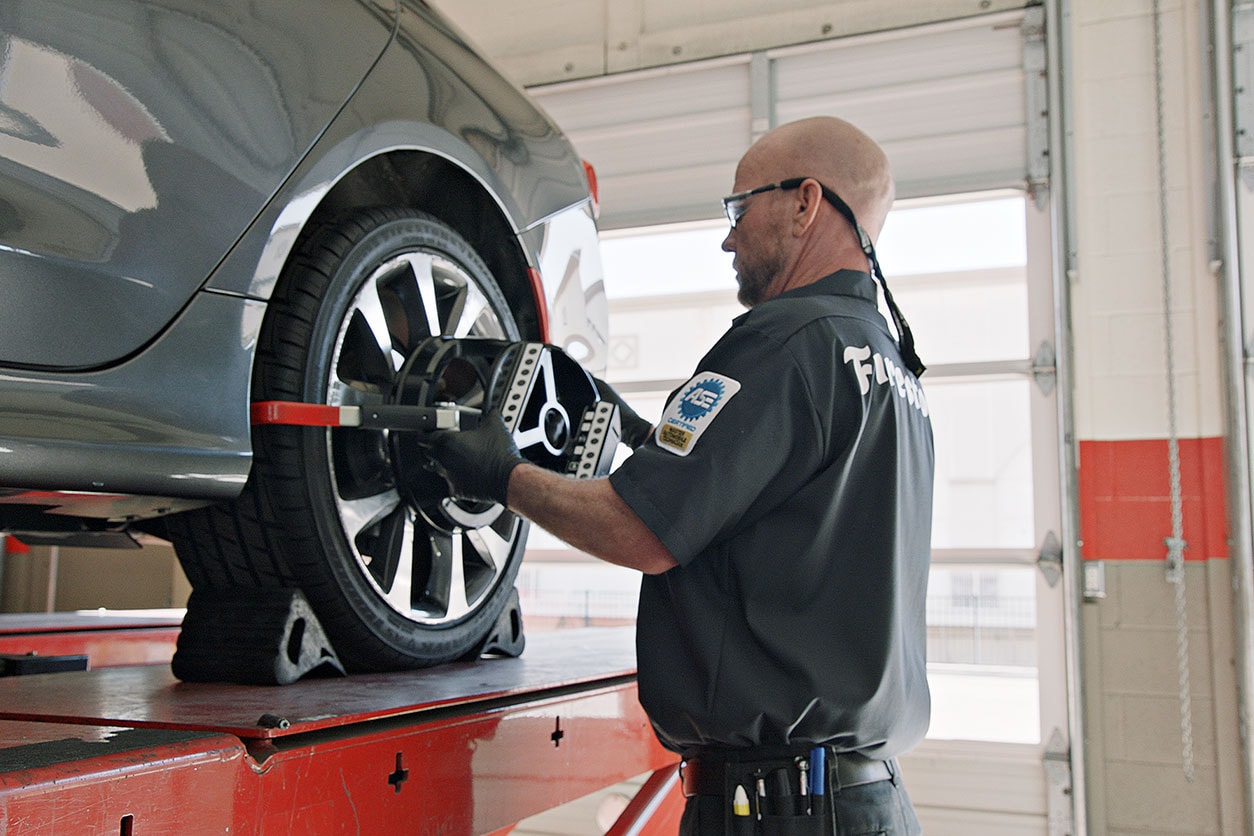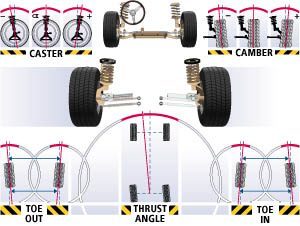Car wheel alignment should be scheduled every 6,000 to 8,000 miles or as needed for optimal performance. Regular alignment maintenance ensures safe driving and prolongs tire lifespan.
Maintaining proper wheel alignment on your vehicle is essential for optimal performance and safety. By scheduling alignment checks every 6,000 to 8,000 miles or as needed, you can prevent uneven tire wear and improve fuel efficiency. Neglecting alignment can lead to issues such as poor handling and increased risk of accidents.
By staying proactive with your maintenance schedule, you can enjoy a smoother and safer driving experience.

Credit: www.firestonecompleteautocare.com
Signs Of Misalignment
Proper car wheel alignment is crucial to avoid misalignment, which can lead to uneven tire wear, steering issues, and decreased fuel efficiency. It is advisable to schedule a car wheel alignment every 6,000 to 8,000 miles or if you notice signs of misalignment such as pulling to one side, vibrating steering wheel, or uneven tire wear.
Pulling To One Side
One of the most common signs of wheel misalignment is when your car constantly pulls to one side while driving. This pulling sensation can make it difficult to keep your vehicle driving straight and steady on the road.
When the wheels are not properly aligned, it can cause uneven tire wear, which can lead to a variety of other issues with your vehicle. This pulling to one side can also cause unnecessary strain on your steering system and suspension, potentially leading to costly repairs.
If you notice any pulling to one side, it is essential to have your car’s wheel alignment checked and adjusted as soon as possible. Ignoring this issue could lead to more severe problems down the road.
Uneven Tire Wear
Another telltale sign of wheel misalignment is uneven tire wear. When your tires are not aligned correctly, certain areas of the tires will experience more friction and wear than others.
| Types of Uneven Tire Wear | Possible Causes |
|---|---|
| Feathering | Toe misalignment |
| Cupping | Shock or suspension problem |
| Scalloping | Wheel balance issue or worn-out suspension components |
| Camber Wear | Excessive positive or negative camber angle |
By regularly inspecting your tires for signs of uneven wear, such as feathering, cupping, scalloping, or camber wear, you can catch wheel misalignment early on and take the necessary steps to correct it.
Remember, ensuring proper alignment not only extends the lifespan of your tires but also contributes to a safer and more comfortable driving experience.
Credit: en.wikipedia.org
Frequency Of Wheel Alignment
Car wheel alignment is crucial for optimal vehicle performance and safety. Properly aligned wheels ensure even tire wear, improve fuel efficiency, and enhance handling. Understanding the frequency of wheel alignment is essential to maintaining your vehicle in top condition.
Regular Maintenance Schedule
Wheel alignment should be part of your regular maintenance schedule to prevent uneven tire wear and ensure a smooth driving experience.
After Specific Events
After specific events such as hitting a pothole or curb, undergoing suspension repairs, or upgrading your tires, it is important to check your wheel alignment to prevent potential issues.
Benefits Of Regular Alignment
Regular wheel alignment has numerous benefits for your car’s performance and maintenance. It is essential to schedule wheel alignments periodically to ensure optimal vehicle operation. Let’s explore the advantages of regular alignment below:
Improved Handling
Regular alignment enhances your car’s stability and ensures smooth steering, leading to a safer driving experience.
Extended Tire Life
Proper alignment prevents uneven tire wear, increasing the lifespan of your tires and helping you save money in the long run.
Cost Considerations
Car wheel alignment should be scheduled based on the manufacturer’s recommendations for optimum performance and safety. Regular alignment can help reduce tire wear, improve fuel efficiency, and prevent potential expensive repairs down the line. Consider the cost of alignment as an investment in the longevity of your vehicle.
Savings On Tire Replacement
One of the primary cost considerations when it comes to scheduling car wheel alignment is the potential savings on tire replacement. When your wheels are not aligned properly, it can cause uneven tire wear. Over time, this can lead to premature tire wear and the need for replacements sooner than expected.
By regularly scheduling wheel alignment, you can ensure that your tires wear evenly and last longer. This means you can postpone the costly expense of tire replacements, saving you money in the long run.
Long-term Maintenance Savings
In addition to savings on tire replacement, there are also long-term maintenance savings to consider when scheduling regular wheel alignment for your car.
Proper wheel alignment helps to maintain the health and longevity of other components related to your car’s suspension system, such as ball joints, tie rods, and control arms. When your wheels are misaligned, these components can experience extra stress and wear, leading to expensive repairs or replacements down the line.
By ensuring your wheels are aligned correctly, you can minimize the risk of damage to these components, significantly reducing your long-term maintenance costs.
Preserving Fuel Efficiency
Another cost consideration when it comes to scheduling car wheel alignment is the impact on fuel efficiency.
When your wheels are misaligned, your car’s engine has to work harder to compensate for the dragging effect caused by the uneven tire wear. This increased effort translates into higher fuel consumption and a decrease in fuel efficiency.
By regularly aligning your wheels, you can help preserve your car’s fuel efficiency, saving you money at the pump over time.
While the frequency of when to schedule car wheel alignment depends on various factors, such as driving conditions and vehicle usage, cost considerations should definitely be a priority. By investing in regular wheel alignment, you can save money on tire replacements, lower long-term maintenance costs, and preserve your car’s fuel efficiency. Don’t overlook the financial benefits of proper wheel alignment for both your wallet and your vehicle’s overall performance.
Diy Alignment Checks
When it comes to ensuring your vehicle’s optimal performance and safety, DIY alignment checks are an essential part of maintenance. Regularly assessing your car’s wheel alignment can help prevent uneven tire wear, improve fuel efficiency, and enhance overall driving stability.
Simple Visual Inspections
To perform a simple visual inspection, start by examining the tires for any signs of uneven wear. Look for differences in tread patterns, which may indicate misalignment. Additionally, check the steering wheel position when driving straight. If it’s off-center or vibrating, it could be a sign of alignment issues. Mark any abnormalities for further assessment.
Test Drive Assessments
Conducting a test drive assessment is another method to gauge alignment. Take note of any pulling to one side, steering wheel vibration, or a vehicle that feels unstable. These issues can point to misalignment problems. Ensure to test the car on both straight roads and during turns to thoroughly assess its steering response and overall stability.

Credit: kevinscarrepair.com
Frequently Asked Questions Of How Frequently To Schedule Car Wheel Alignment?
How Often Should Wheel Alignment Be Done?
Wheel alignment should be done every 6,000 miles or if you notice steering issues or uneven tire wear.
How Many Miles Should An Alignment Last?
Typically, an alignment should last around 20,000-30,000 miles depending on driving conditions and maintenance.
Do You Need An Alignment Every Time You Change Your Wheels?
No, you do not always need an alignment when changing your wheels. However, it is generally recommended to get an alignment if you notice any issues such as uneven tire wear or pulling to one side.
How Long Can I Drive My Car Without An Alignment?
Driving your car without alignment can lead to uneven tire wear and handling issues. It’s recommended to get an alignment every 6,000 to 8,000 miles, or whenever you notice steering problems or uneven wear on your tires. Regular alignments help maintain your vehicle’s performance and safety.
Conclusion
To ensure optimal performance and safety, regular car wheel alignment is key. By maintaining a proper alignment, you can prevent uneven tire wear, improve fuel efficiency, and enhance overall drivability. The frequency of wheel alignment depends on various factors such as your driving style, road conditions, and recommendations from your vehicle manufacturer.
Regular inspections and alignments can help catch any issues early on and save you from expensive repairs down the line. Prioritize car wheel alignment to enjoy a smooth and trouble-free driving experience.
